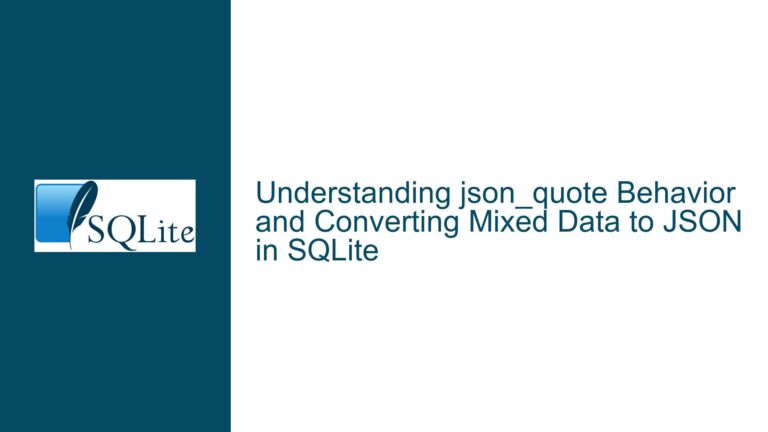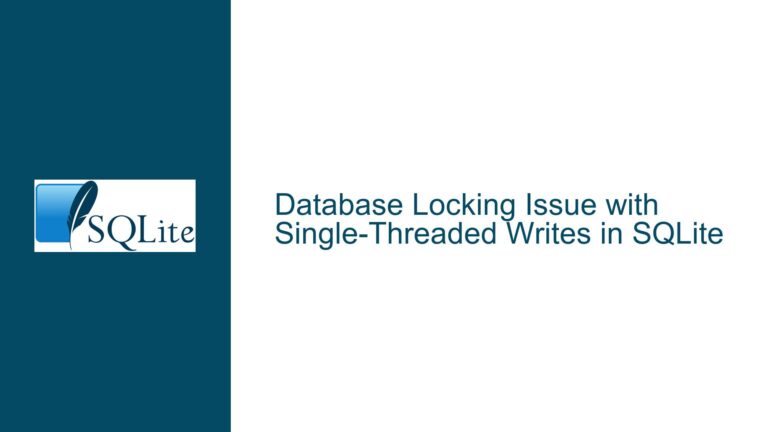Generating Month-End Dates Between Two Dates in SQLite Without Infinite Loops
Understanding the Problem: Generating Month-End Dates in a Recursive CTE
The core issue revolves around generating a series of month-end dates between two specified dates in SQLite using a recursive Common Table Expression (CTE). The initial attempt resulted in an infinite loop, causing the query to run out of memory. This problem arises due to the way SQLite handles date calculations and recursion, particularly when dealing with month-end dates. The challenge is to ensure that the recursive CTE correctly calculates the month-end dates without entering an infinite loop or producing incorrect results.
The initial query attempted to generate month-end dates by starting with a specific date (2017-05-31) and recursively adding one month to the previous date. However, this approach failed because the recursive step did not account for the variability in month lengths (e.g., February has 28 or 29 days, while other months have 30 or 31 days). As a result, the query kept recalculating dates within the same month, leading to an infinite loop.
Why the Initial Approach Fails: Infinite Loops and Incorrect Date Calculations
The primary cause of the infinite loop in the initial query is the incorrect handling of month-end dates within the recursive CTE. When the query attempts to calculate the next month-end date by adding one month to the previous date, it does not correctly account for the fact that the resulting date might not be the actual end of the month. For example, adding one month to 2017-05-31 results in 2017-06-31, which is not a valid date. SQLite’s date functions handle this by rolling over to the next valid date, but this behavior disrupts the logic of the recursive CTE.
Another issue is the reliance on the previous date (DateVal) to calculate the next date. Since DateVal is always a month-end date, adding one month to it does not guarantee that the resulting date will be the end of the next month. This leads to the recursive step recalculating the same month-end date repeatedly, causing the infinite loop.
The solution lies in decoupling the calculation of the next date from the previous month-end date. Instead of using the previous month-end date as the base for the next calculation, the query should use a fixed starting point (e.g., the first day of the month) and calculate the month-end date from there. This approach ensures that the recursive step always produces the correct month-end date without entering an infinite loop.
Correcting the Query: Using a Counter and Fixed Starting Point
The corrected approach involves using a counter to track the number of months added to the base date and calculating the month-end date from the base date plus the counter. This ensures that the recursive step always produces the correct month-end date without relying on the previous month-end date. The counter starts at 2 because the first month-end date is already handled by the initial select statement.
Here is the corrected query:
WITH RECURSIVE MonthEndDates(DateVal, BaseDate, MonthNo, FinalMonth) AS (
SELECT '2017-05-31', '2017-05-01', 2, '2018-01-01'
UNION ALL
SELECT date(BaseDate, '+' || MonthNo || ' month', 'start of month', '-1 day'), BaseDate, MonthNo+1, FinalMonth
FROM MonthEndDates
WHERE DateVal < FinalMonth
)
SELECT DateVal FROM MonthEndDates;
In this query, BaseDate is the fixed starting point (2017-05-01), and MonthNo is the counter that tracks the number of months added to the base date. The recursive step calculates the month-end date by adding the counter to the base date, moving to the start of the month, and then subtracting one day. This ensures that the resulting date is always the correct month-end date.
The WHERE clause ensures that the recursion stops when the calculated month-end date exceeds the final month (2018-01-01). This prevents the query from entering an infinite loop and ensures that it produces the correct series of month-end dates.
Alternative Approach: Using a Separate Increment Date
Another approach is to use a separate increment date (incDate) to track the progression of months and calculate the month-end date from the increment date. This approach avoids the need for a counter and simplifies the recursive step. The increment date starts one month after the initial month-end date to ensure that the first month-end date is already handled by the initial select statement.
Here is the alternative query:
WITH RECURSIVE MonthEndDates(DateVal, incDate) AS (
SELECT '2017-05-31', '2017-06-01'
UNION ALL
SELECT date(incDate, '+1 month', 'start of month', '-1 day'), date(incDate, '+1 month')
FROM MonthEndDates
WHERE DateVal < '2018-04-30'
)
SELECT DateVal FROM MonthEndDates;
In this query, incDate is the increment date that tracks the progression of months. The recursive step calculates the month-end date by adding one month to the increment date, moving to the start of the month, and then subtracting one day. The WHERE clause ensures that the recursion stops when the calculated month-end date exceeds the final month (2018-04-30).
This approach is simpler and more intuitive than using a counter, but it requires careful handling of the increment date to ensure that the correct month-end dates are produced. The key is to start the increment date one month after the initial month-end date to avoid recalculating the same month-end date repeatedly.
Conclusion: Best Practices for Generating Month-End Dates in SQLite
Generating a series of month-end dates between two dates in SQLite requires careful handling of date calculations and recursion. The key is to avoid relying on the previous month-end date to calculate the next date, as this can lead to infinite loops and incorrect results. Instead, use a fixed starting point and a counter or a separate increment date to track the progression of months and calculate the month-end dates correctly.
The corrected queries provided in this post demonstrate how to generate month-end dates without entering an infinite loop or producing incorrect results. By following these best practices, you can ensure that your SQLite queries produce the correct series of month-end dates and avoid common pitfalls associated with recursive CTEs and date calculations.






